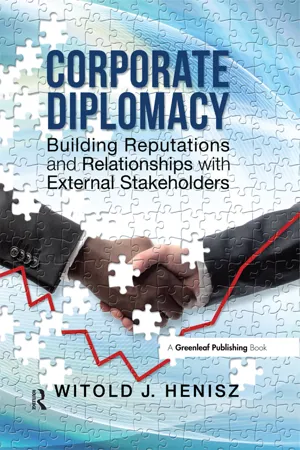
Corporate Diplomacy
Building Reputations and Relationships with External Stakeholders
- 223 pages
- English
- ePUB (mobile friendly)
- Available on iOS & Android
Corporate Diplomacy
Building Reputations and Relationships with External Stakeholders
About This Book
Managers of multinational organizations are struggling to win the strategic competition for the hearts and minds of external stakeholders. These stakeholders differ fundamentally in their worldview, their understanding of the market economy and their aspirations and fears for the future. Their collective opinions of managers and corporations will shape the competitive landscape of the global economy and have serious consequences for businesses that fail to meet their expectations.
This important new book argues that the strategic management of relationships with external stakeholders – what the author calls "Corporate Diplomacy" – is not just canny PR, but creates real and lasting business value.Using a mix of colourful examples, practically relevant tools and considered perspectives, the book hones in on a fundamental challenge that managers of multinational corporations face as they strive to compete in the 21st century.
As falling communication costs shrink, the distance between external stakeholders and shareholder value is increasingly created and protected through a strategic integration of the external stakeholder facing functions. These include government affairs, stakeholder relations, sustainability, enterprise risk management, community relations and corporate communications. Through such integration, the place where business, politics and society intersect need not be a source of nasty surprises or unexpected expenses.
Most of the firms profiled in the book are now at the frontier of corporate diplomacy. But they didn't start there. Many of them were motivated by past failings. They fell into conflicts with critical stakeholders – politicians, communities, NGO staffers, or activists – and they suffered. They experienced delays or disruptions to their operations, higher costs, angry customers, or thwarted attempts at expansion.
Eventually, the managers of these companies developed smarter strategies for stakeholder engagement. They became corporate diplomats. The book draws on their experiences to take the reader to the forefront of stakeholder engagement and to highlight the six elements of corprate diplomacy.
Frequently asked questions
One
Due diligence:
- Which stakeholders matter most?
- Which grievances should I stress?
- Which stakeholders should I rely on to introduce me to others?
- How are stakeholders learning about me and how can I influence their opinions?
Stakeholder data
Individual-level data
Who are your stakeholders?
How powerful are your stakeholders independently?
Is a stakeholder’s disposition towards the project cooperative or oppositional? Are your operations perceived as legitimate?
How motivated are stakeholders by the opinions of their peers?
What issues matter to your stakeholders?
Relational data
How strong are the connections between stakeholders?
Are relationships cooperative or conflictual? Do they afford each other a social license?
Summary of data structure
Data sources
Expert assessments
In-depth stakeholder surveys
Table of contents
- Cover
- Half Title
- Title
- Copyright
- Dedication
- Contents
- Acknowledgments
- Preface
- Introduction
- 1 Due Diligence: Mapping and Analysis of Your Stakeholders
- 2 Integration: From Stakeholder Maps to Financial and Operational Performance
- 3 Personal: Stakeholder Relationships Are Personal Relationships
- 4 Learning: Humility in Adapting to Negative Feedback in a Necessarily Imperfect Strategy
- 5 Openness: Strategic Communications to Reinforce Trust and Reputation
- 6 Mindset: Externally Facing Long-term Organizational Culture
- Conclusion: 12 Traps to Avoid
- Endnotes
- About the author
- Index